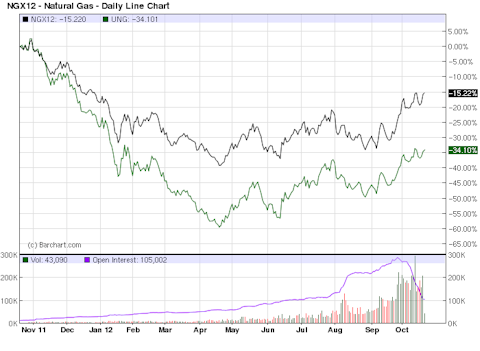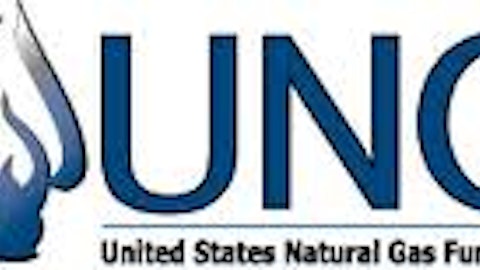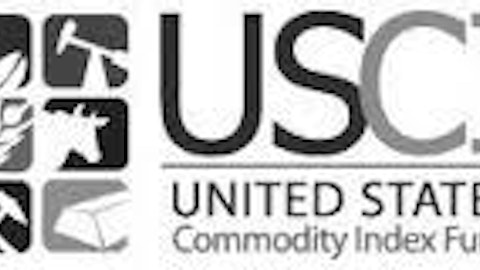
After losing 98% since inception and enduring multiple reverse splits just to stay open, the fund finally caught some traction this year as natural gas surged, sending this fund up over 50% in just a few short weeks. But to put that in perspective, that 50% was still not enough to turn UNG positive for 2012, as it still has a negative performance on the year, as well as just about any other time period you can choose from.
Aside from performance woes, the next biggest complaint has been UNG’s inability to accurately track the movements of natural gas prices. Because United States Natural Gas Fund, LP (NYSEARCA:UNG) is an ETF, it is subject to tracking error, something that never occurs with an ETN, and that can lead to some head-scratching results. Also, UNG’s front-month roll strategy means it will always fall prey to the nasty effects of contango. UNG will almost always slightly underperform NG given that it charges a fee of 60 basis points for investment, but many wonder just how bad the tracking error and contango drag really are [see also 3 ETFs For The Natural Gas Recovery].
UNG vs. Natural Gas: A Clear Winner
It’s bad, really bad. When it comes to UNG’s ability to track long-term natural gas prices, the past year has been abysmal for this product. In the trailing year, NG futures have surrendered around 15%, while UNG has given up over 33%, more than double the losses of the commodity it supposedly tracks. The chart below shows the returns of natural gas futures versus this ultra popular fund over the last year.

Though UNG’s movements seem to mimic that of NG, the movements are all relative, as contangoed NG markets combined with tracking error have clearly gouged the ETF this year. When you drag that chart out to five years, NG prices dip 54%, while UNG sinks 93%. Note that for a brief period in 2008 when natural gas enjoyed a bull run, United States Natural Gas Fund, LP (NYSEARCA:UNG) had actually outperformed, but ever since the sentiment has turned bearish for this fossil fuel, the ETF has been in a virtual free-fall.
So Why Use UNG?
Great question. If you are a long term investor, you probably have no business buying and holding this fund. There are, instead, a number of other options with more compelling investment theses like Natural Gas Futures Contango (NYSEARCA:GASZ), Teucrium Natural Gas Fund (NYSEARCA:NAGS), and even the equity-based First Trust ISE Revere Natural Gas (NYSEARCA:FCG). But when it comes to active trading, United States Natural Gas Fund, LP (NYSEARCA:UNG) is second to none in the natural gas industry [see also Beyond UNG: Three Intriguing ETFs To Play Natural Gas].
This fund was built for active traders, and should really only be used by those who have the discipline and time to watch over its movements carefully. When it comes to making a short-term speculative bet on NG prices, or playing daily movements like every Thursday’s EIA Natural Gas Report, UNG is going to be one of the best securities in the world. The ETF has over $1.2 billion in assets and trades more than 10 million shares each day. That combined with an active options market makes this one of the most liquid and trade-able commodity instruments on the market.
The tracking error and contango issues for United States Natural Gas Fund, LP (NYSEARCA:UNG) do not make it a bad fund, they make it a bad fund for certain investors. Any other commodity ETF like United States Oil Fund LP (NYSEARCA:USO) or United States Brent Oil Fund, LP (NYSEARCA:BNO) will exhibit the same issues, but it takes an educated investor to make a proper play on these products. If you are looking for a long-term natural gas play, don’t bother with UNG, you will probably end up pulling your hair out. But traders and speculators will be hard pressed to find a better, more liquid option out there. The tracking error or contango will not be very damaging on a day-to-day basis for a trader, it is when that process is dragged out over an extended period of time that UNG’s shortcomings are evident.
This article was originally written by Jared Cummans, and posted on CommodityHQ.


